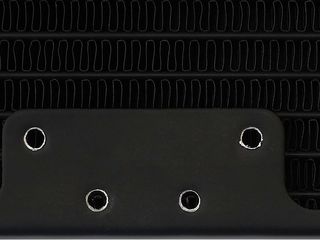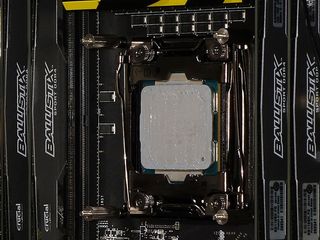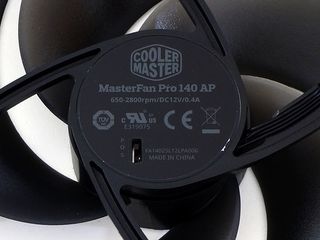Early Verdict
The Cooler Master MasterLiquid Pro 280 performs well but unexceptionally. We’d base our purchase decision upon the availability of discounts.
Pros
- +
Good cooling performance
- +
High “Mean Time To Failure” rating
- +
View window for coolant inspection
Cons
- -
Unexceptional 2-year warranty undercuts MTTF rating
- -
Only a good value during discount promotions
Why you can trust Tom's Hardware
Features & Specifications
The MasterLiquid Pro 280 is a step up in size from the previously reviewed MasterLiquid Pro 240, yet it shares the same design and even ships with a 120x240mm fan damper. The upsized fans even have the same style of bolted-on rubber frame corners. It’s still compatible with all of Intel’s square-ILM LGAs and AMD’s legacy rectangular-pattern mounting holes, but buyers are now eligible for a free AM4 bracket set from Cooler Master.
Specifications
MORE: In Pictures: 20 Clever Liquid-Cooled PC Setups
Features


The first batch of MasterLiquid Pro 280s didn’t even ship with 140mm gaskets, which is a shame since the included fan screws are too short to use without that rubber spacer. Cooler Master has upgraded consecutive shipments with a pair of individual 140mm rubber spacers.

The larger radiator carries forward the square-folded fins of its smaller sibling, and even adds 120mm mounting holes to its 140mm standard. Designed only to fit 2x 140mm radiator mounts, the radiator’s 120mm fan mounts are spaced farther apart than most 2x 120mm radiator mounts.



The MasterLiquid Pro 280 pump is identical to that of the 240 model, right down to the lighted cap window. Its copper base is finely machined and appears perfectly flat. A narrow slot above the mounting flange holds the builder’s selection of Intel or AMD mounting brackets.

Brackets on the MasterLiquid Pro 280’s head unit bolt to either a pair of LGA 2011x standoffs or a set of included carriage screws. The screws are keyed to fit the various positions of the included socket support plate.

Cooler Master’s MasterFan Pro 140 AP has a three-speed selector atop its motor, which is unfortunate for us since accessing it requires us to remove the radiator to get to the furthest fan screws and then remove both fans. Tests on an unmounted fan showed approximate rotational speed of 2840, 2100, and 1560 RPM.

The installed cooler’s appearance varies from the earlier 240 model only in the size of its radiator and fans.
MORE: Best CPU Cooling
MORE: How To Choose A CPU Cooler
MORE: All Cooling Content
-
10tacle I would have liked to see the $130 Corsair H115i EP thrown in the mix for comparison but overall an excellent review. We can't have too many CPU cooler reviews!Reply -
munizj1 The absence of a comparison to any Corsair AIO's or even NZXT's current X62 is...strange.Reply -
Crashman Reply
It would also be strange to include any coolers we haven't reviewed :)19717789 said:The absence of a comparison to any Corsair AIO's or even NZXT's current X62 is...strange.
-
the nerd 389 Reply19717789 said:The absence of a comparison to any Corsair AIO's or even NZXT's current X62 is...strange.
The x61 is essentially identical to the x62 except for the LEDs. -
JackNaylorPE Review covers the basics but ... did I miss it or was there any mention of radiator material ? Not commenting on what's there but what isn't. Methinks a cooler review needs to go beyond what can be found in the press release and a few comparisons with a couple of clone like designs. I read reviews to find out the things that the manufacturer intentionally leaves out. As for comparisons, the things I look for in a AIO cooler review are:Reply
a) Can it come close to the noise / thermal performance of the better / cheaper air coolers ?
b) Can it come close to competing w/ OLC type AIOs w/ copper rads and moderate speed fans ?
c) All materials.
d) And tho checking things like pump flow would be illuminating, it is recognized that you'd have to destroy the CLC to get this info ... but would be nice to know if manufacturer was forthcoming with this type of data.
Also would like to know more about the window that lets you see the coolant ...not seeing a value if you don't like what you see, you can't you do anything about it. Wish this was fleshed out some. -
the nerd 389 Reply19719425 said:Review covers the basics but ... did I miss it or was there any mention of radiator material ? Not commenting on what's there but what isn't. Methinks a cooler review needs to go beyond what can be found in the press release and a few comparisons with a couple of clone like designs. I read reviews to find out the things that the manufacturer intentionally leaves out. As for comparisons, the things I look for in a AIO cooler review are:
a) Can it come close to the noise / thermal performance of the better / cheaper air coolers ?
b) Can it come close to competing w/ OLC type AIOs w/ copper rads and moderate speed fans ?
c) All materials.
d) And tho checking things like pump flow would be illuminating, it is recognized that you'd have to destroy the CLC to get this info ... but would be nice to know if manufacturer was forthcoming with this type of data.
Also would like to know more about the window that lets you see the coolant ...not seeing a value if you don't like what you see, you can't you do anything about it. Wish this was fleshed out some.
For an AIO, the radiator material isn't as much of an issue. The loop is much more tightly controlled than open-loop designs. Any engineer worth their salt would ensure that if they use an aluminum rad, the rest of the components will either also be aluminum or galvanically isolated. That's nearly impossible to do in an open loop.
Regarding OLC coolers, the reviews are a few clicks away. The summary is basically that the Celsius S24 handily beats this cooler, and this cooler handily beats the other OLC options.
Lastly, it's fairly easy to check coolant flow without opening the loop. All you have to do is use the CPU power and instantaneous coolant temperature change to derive the heat capacity per minute. That translates directly into flow via mass per second and the heat capacity of water. That's easy if the coolant sensor is before the radiator, but requires removing the fans and wrapping the radiator if the sensor comes after the radiator. It's worth noting that above about 0.2 GPM, coolant flow doesn't really come into play until you push a lot of heat into the loop, and then double up on the fans and run them at full speed. -
brucewithatemper The $130 Corsair H115i EP would've been a great comparison for the review. But overall, great review! Keep em coming brother!Reply -
dstarr3 According to this, the Arctic Liquid Freezer 240 is the cheapest, the coolest, and the quietest. Sooooo... why buy anything else?Reply -
10tacle Reply19721291 said:According to this, the Arctic Liquid Freezer 240 is the cheapest, the coolest, and the quietest. Sooooo... why buy anything else?
Many people take more into consideration than just raw performance and noise. Warranty being one example. Both the Arctic Cooling and Cooler Master coolers only have a 2-year warranty compared to Corsair's 5-year warranty with their H115i EP (all Corsair closed loop coolers come with a 5-year warranty).
I for one would gladly spend $30 more on a cooler with a 5-year warranty...especially if it outperforms both the $90-$100 coolers (which it does). As well as I'd rather spend the same $100 on an H100i with a 5-year warranty even if it's behind the other coolers by a few C in performance. -
the nerd 389 Reply19721777 said:19721291 said:According to this, the Arctic Liquid Freezer 240 is the cheapest, the coolest, and the quietest. Sooooo... why buy anything else?
Many people take more into consideration than just raw performance and noise. Warranty being one example. Both the Arctic Cooling and Cooler Master coolers only have a 2-year warranty compared to Corsair's 5-year warranty with their H115i EP (all Corsair closed loop coolers come with a 5-year warranty).
I for one would gladly spend $30 more on a cooler with a 5-year warranty...especially if it outperforms both the $90-$100 coolers (which it does). As well as I'd rather spend the same $100 on an H100i with a 5-year warranty even if it's behind the other coolers by a few C in performance.
Fractal Design also offers a 5-year warranty. What's even better is that you don't void the warranty if you open the loop and expand it. It still covers the original components of the cooler.

